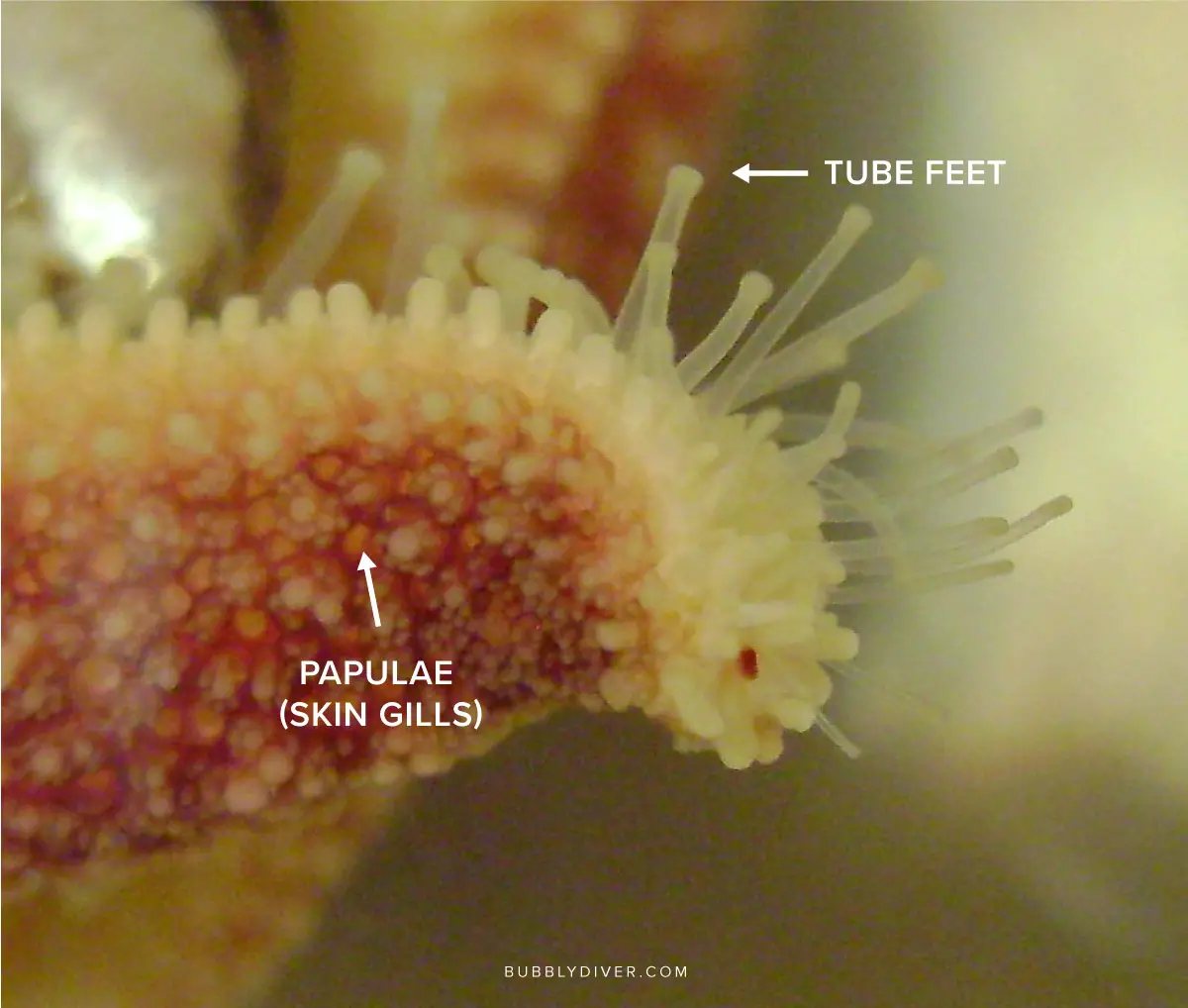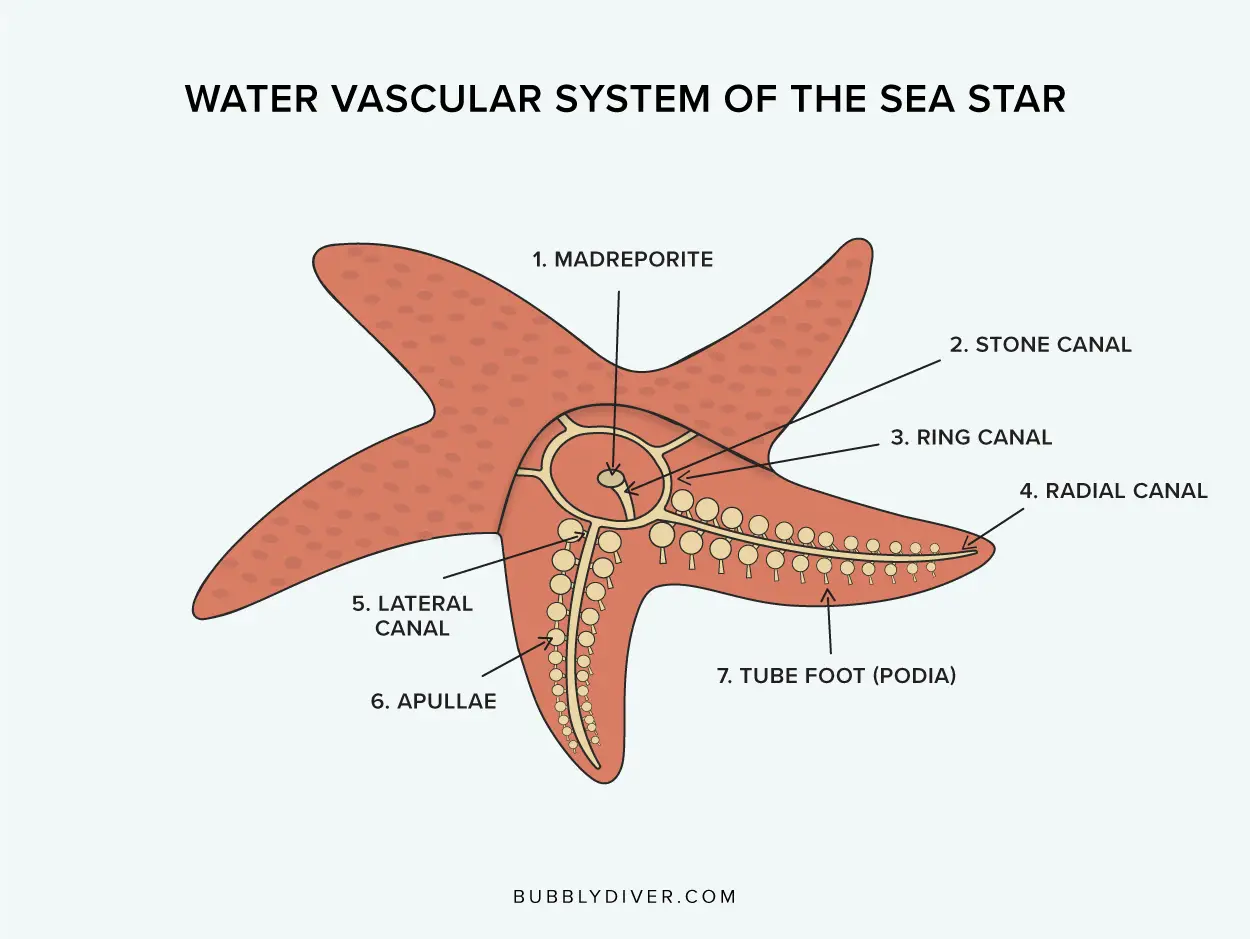Do Starfish Have Gills?
Starfish are fascinating marine creatures without true brains, blood, or hearts. They adapted so well to their environment that they don’t need most of the organs we would expect them to have. If you wonder whether starfish have gills or not, we’ll talk all about that in this post. However, let’s begin with a quick answer:
Starfish don’t have gills. They use their papulae (skin gills) and tube feet to absorb the oxygen directly from the seawater and exchange gases.
However, this doesn’t tell the whole story. Below I’ll explain how starfish use their skin gills and tube feet for breathing. Furthermore, I’ll explain how starfish respiratory system works and if they can breathe out of the water. Read on!
Starfish skin gills and tube feet
Instead of regular gills, starfish use two organs for breathing: skin gills and tube feet.
Skin gills are also called dermal gills or papulae. They are numerous thin-walled extensions on the starfish’s aboral surface (on top of their bodies). They contain extensions of the coelom (main body cavity) and enlarge the surface area for respiratory exchange.
These papulae are very soft tissue patches supported by collagen fibers. They’re set at right angles to each other and arranged in a three-dimensional web with the ossicles and papulae in the crevices. This arrangement allows both the starfish’s arms to bend easily and the rapid onset of the stiffness and stiffness required for stressful breathing activities.
Tube feet are the second organ that takes part in the respiratory system of the starfish. They are small flexible appendages located on the underside of their body. They connect the water vascular system which is a part of the starfish’s circulatory system. You can read more about it in my other blog post “Do Starfish Have Blood And A Heart?”.
The water travels through small canals of the water vascular system and exchanges gases. During that exchange it also allows the starfish to move around the seafloor by extending the feet.

Starfish respiratory system
Now, let’s take a closer look at how the respiratory system of the starfish looks and works. Although starfish don’t have actual gills, they did develop a respiratory system. They have an open respiratory system as the oxygen can move freely in and out of the body.
As I mentioned, one of the organs used for respiration is the papulae. These gills are lined with cilia that move to produce a current. Next, the current brings water abundant in oxygen, and it enters the interior of the starfish’s body by diffusion. The papulae, due to their very thin-walled outer layer, help in the proper diffusion process.
The carbon dioxide that is more abundant in the interior of the starfish’s body travels by diffusion into seawater together with other wastes, such as ammonia. Therefore, gases and other tiny substances move from places where they’re most abundant to where they’re least. This is how gases are exchanged.
Coelom
It’s also worth mentioning that starfish have a spacious coelom – an open, fluid-filled body cavity lined with tissue. The hollows of the papulae are continuous with the coelom.
Therefore, a respiratory water current is created during the continuous exchange of gases, which passes through the papulae by cilia lining their outer surface towards the coelomic cavity. The cilia that line the celomic cavities cause the flow of the celomic fluid into them.
As a result, oxygen is delivered to the celomic fluid, and carbon dioxide is carried outside the body. Therefore, it is said that in a starfish, gas exchange occurs through branched protrusions of the body wall connected at the base to the celomic cavity.
The coelom is not only part of the respiratory system but also functions as an excretory system. When the liquid collects, the waste inside the starfish body, such as CO2, provides them with oxygen and small nutrients. This way, starfish breathe but also clean themselves.
Water vascular system
Starfish tube feet work as “secondary gills.” These hundreds or thousands of feet are connected to a system of canals called water vascular system.

During the circulation, the water enters through madreporite (also called a sieve plate) – a small, smooth plate located on the aboral side of the sea star, slightly off the center, and flows to the tube called a stone canal.
Next, the water goes into a ring canal that circulates the sea stars’ center of the body and connects with a radial canal.
The radial canal runs throughout the length of each arm of the sea star, and it terminates as the lumen of a terminal tentacle. The canal runs immediately to the oral side of the ambulacral muscles. The radial canal spreads into two series of short and narrow branches called lateral canals.
Each of the lateral canals has a valve inside to prevent a backward flow of the water into the radial canal. Next, these canals are connected to the base of tube feet and their ampulla.
The ampulla is the suction cup at the end of sea stars’ tube feet (also called podia) that create contractions. When the sea star wants to make suction, the ampulla pulls water out of the podia. When it wants to extend the tube feet, the suction cup pushes the water into the end of each foot.
This is how the water vascular system works to exchange gases and nutrients. But this unique system of canals has more functions than “just” that. It helps sea stars to move, catch food, and attach to the rocks.
Read my other blog post, “Do Starfish Have Blood And A Heart?” to learn more about the water vascular system and sea stars use it as a circulatory system.
Can starfish breathe out of water?
Starfish cannot breathe out of water. They capture oxygen from the water but can’t do it from the air. Most species can hold their breath only for about 30 seconds, so it’s important not to take them out of the water when you see them. Another reason not to take the sea creatures out of the water by our hands is that we can transport diseases and poison them.
It can be caused by our natural oil, bacteria, or chemicals, such as sunscreen.
Are starfish fish or not?
As you already may notice the difference, starfish are certainly not fish. Fish do have gills and are vertebrates (have a backbone). Starfish are invertebrates without a backbone. They do however have an internal skeleton composed of calcium carbonate, beneath their skin. You can read more about it in my other blog post: “Do Starfish Have Bones?”
Starfish is a common name but they are actually sea stars. They belong to the class Asteroidea within the phylum Echinodermata. All other echinoderms have radial symmetry and calcium carbonate skeletons as well. Other animals in this group are sea cucumbers, brittle stars, sea urchins, and sea lilies.
The other significant difference is that fish have hearts and blood but starfish don’t. You can read more about it in my other blog post: “Do Starfish Have Blood And A Heart?”
You may also like:

Welcome to Bubbly Diver!
I’m glad to see you here. This blog is created for all marine creature lovers by a bubbly diver - me, Dori :)


